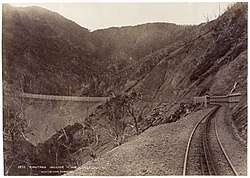Rimutaka Incline railway accident
The Rimutaka Incline railway accident occurred on 11 September 1880 when the leading three carriages on a Greytown to Wellington train were blown off the track in strong winds near the Siberia tunnel; killing four passengers.[1] The Rimutaka Incline section of the line over the Rimutaka Ranges between Wellington and the Wairarapa used the Fell system on the steep 1 in 15 section which was 4.8 km (3.0 mi) long.
| Rimutaka Incline railway accident | |
|---|---|
| Details | |
| Date | 11 September 1880 |
| Location | Rimutaka Incline, Rimutaka Ranges |
| Country | New Zealand |
| Line | Wairarapa Line |
| Operator | New Zealand Railways Department |
| Incident type | Derailment |
| Cause | Extreme wind gusts |
| Statistics | |
| Trains | 1 |
| Deaths | 4 |
A small train left Greytown at 8.30am bound for Wellington. At Cross Creek, at the foot of the Rimutaka Ranges, a Fell Engine (H class) was added to the train to push it up the steep 1 in 15 ascent to the summit of the Rimutaka Incline. At Cross Creek the two passenger cars and the luggage carriage were put in front of the engine. Then behind this were two wagons of timber and lastly the Fell brake van.
All went well until the train reached an area of the incline known as Siberia. A strong north-west wind was blowing across the track. A terrific gust hit the three leading carriages, which were blown off the railway line. The body of the first carriage was torn from its mountings and the passengers were thrown onto the hillside, although the couplings held. The weight of the engine prevented the carriages from falling into the valley below, and the grip of the engine on the raised centre-rail saved the whole train from destruction and more loss of life. The engine and brake van also had brakes which gripped the raised centre rail. The rear brakesman uncoupled his van and piloted the van down the incline to Cross Creek to get help.
Three children were killed instantly and there were many injuries, some horrific. One of the injured, Stanley George Nicholas aged 5 years, died later from injuries received. The inquest found that the deaths were accidental, caused by the carriages being blown off the line, and no blame was attached to anyone. Action was urged to erect windshelters on dangerous parts of the incline, and this was done. When the wind was fierce, two engines were used on the incline.
1936 wind accident

On 8 October 1936 a railcar (R.M.6.) travelling south on the Wairarapa line was blown off the track by a gust estimated at 128 km/h (80 mph). Eight passengers, seven of whom were women, were injured. The accident happened between Featherston and Pigeon Bush, just before a large wooden breakwind.
References
- Terrible Railway Accident at Wellington, N.Z. The Illustrated Australian News, 9 October 1880, at Trove (Sourced to unnamed N.Z. newspapers)
- Conly, Geoff; Stewart, Graham (1986). Tragedy on the Track: Tangiwai & other New Zealand Railway Accidents. Wellington: Grantham House Publishing. pp. 73–77. ISBN 978-1-86934-008-7.
- Te Ara Encyclopaedia of New Zealand